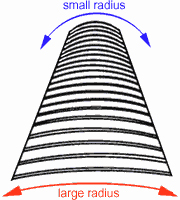Compound (or conical) radius fretboards are an attempt to get the “best of both worlds” between smaller and larger radii.

The radius of these fretboards changes as you climb the neck, starting out more curved at the nut and gradually getting flatter, with the effect that each fret is a fraction flatter than the one before it. While a normal fixed radius is a segment of a circle or cylinder, a conical radius is actually a segment of a cone.
The idea is that players tend to bend higher up the neck and play chords lower down. The larger radius higher up on the neck lets you get the action down lower and still bend cleanly, while the smaller radius nearer the nut makes chording easier.
Compound radius fret dressing
One way of making smaller radius fingerboards better for bending is to dress the frets from about the 10th or 12th fret with a flatter radius.
This fret dress method makes the fretplane compound without needing to remove the frets, dress the fingerboard and refret again.
This is something that is very easy to implement with the Plek machine. See the Virtual Fret Dress section for more detail.

